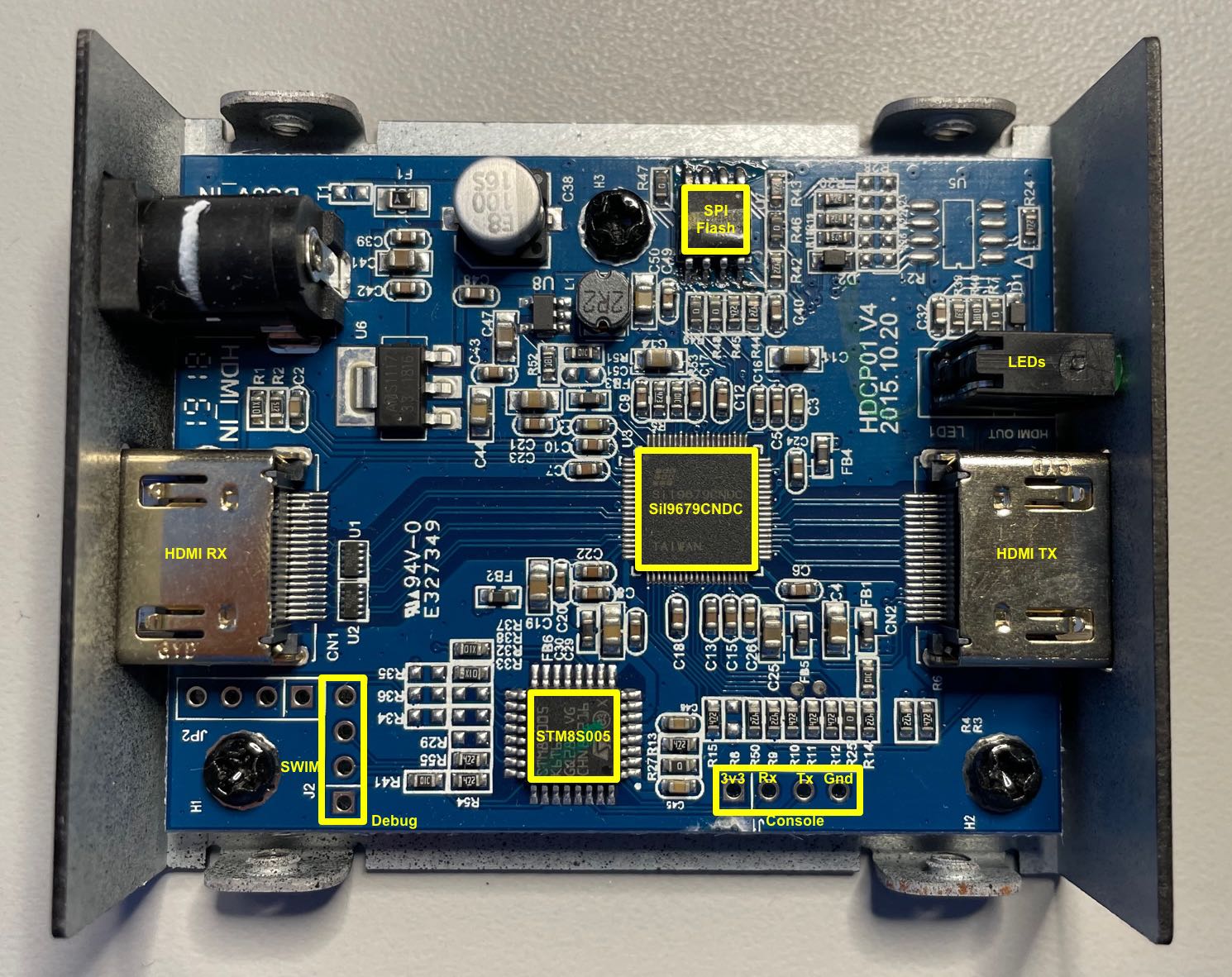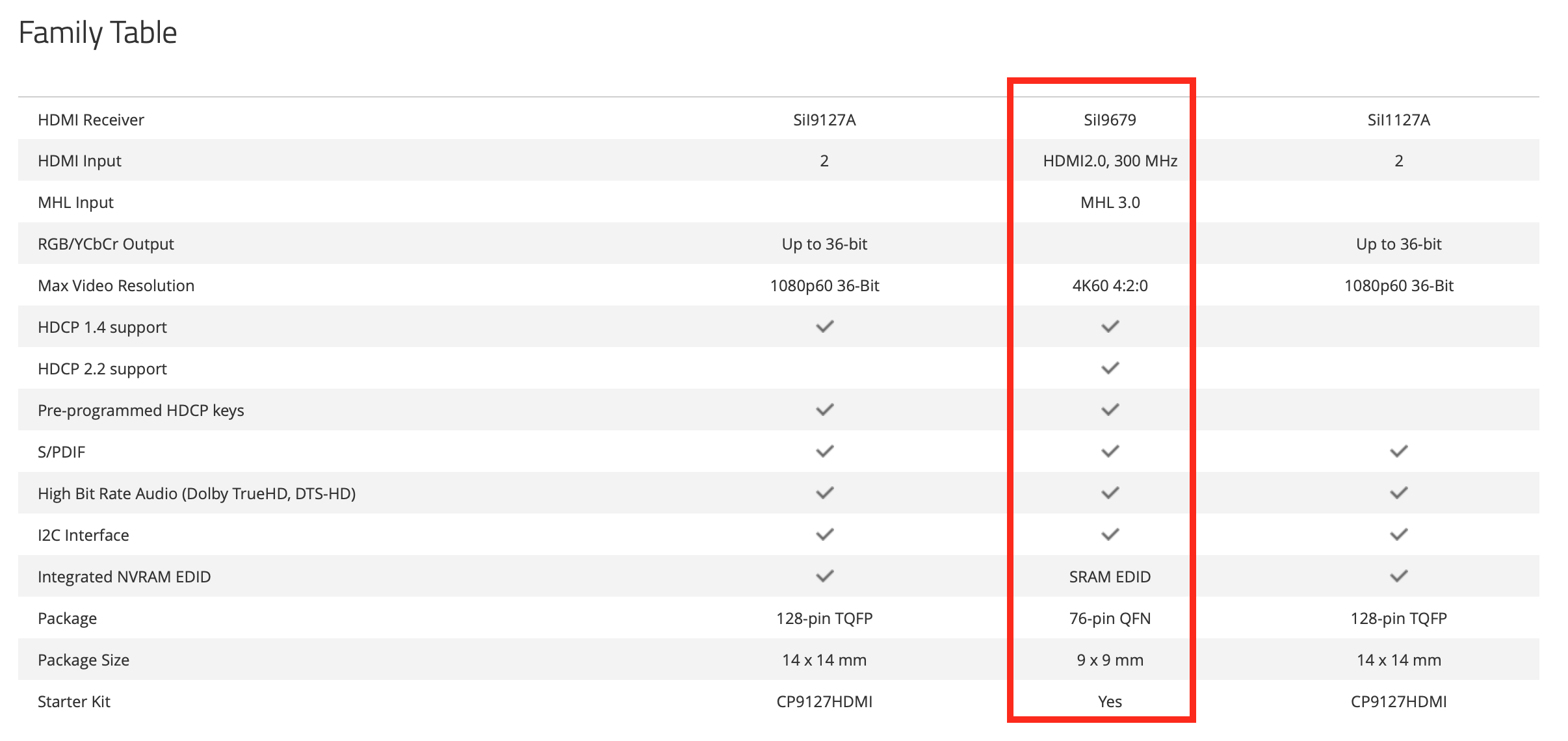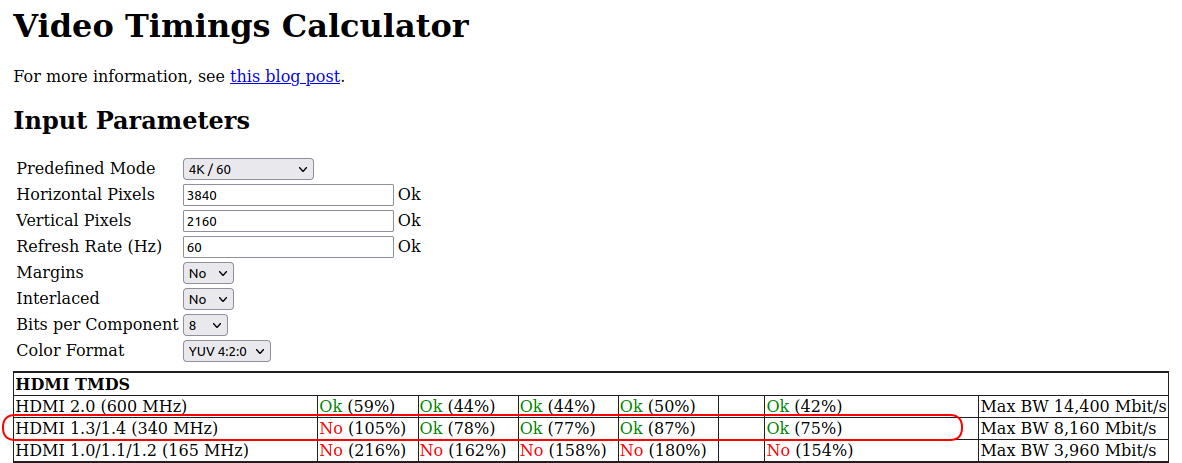Analyzing the Monoprice Blackbird HDCP 2.2 to 1.4 Down Converter
- Introduction
- Some Words about HDCP
- Inside the Monoprice Blackbird 4K Pro
- The Test
- Digging Deeper: UART Transactions
- Decoding HDCP I2C Transactions
- The Legality of It All
- References
- Footnotes
Introduction
I got my hands on a Monoprice Blackbird 4K Pro HDCP 2.2 to 1.4 Converter. According to the marketing copy it “is the definitive solution for playback of new 4K HDCP 2.2 encoded content on 4K displays with the old HDCP 1.4 standard.”
Stuffed after a delicious Thanksgiving meal, I decided to take it apart after the guests had left. It’s a simple single-function device, so I didn’t expect much, but maybe there’s some things to be learned?
Some Words about HDCP
If you want a cryptographically secure system, there’s nothing worse than creating your own custom protocol instead of proven one, but that’s exactly what happened in the case of High-Bandwidth Digital Content Protection (HDCP).
Version 1 was developed somewhere at the beginning of the century and turned out to be terribly broken. By 2010, it was completely defeated with the release of the master key1 that can be used to generate transmit and receive keys at will.
To keep Hollywood happy, a successor was invented: HDCP 2.0, an entirely new protocol with no similarities to revision 1. This time, the creators used proven cryptography algorithms such as public key authentication, and 128-bit AES encryption. HDCP 2.1 added the concept of content stream types to block the retransmition of high quality video streams (e.g. 4K or HDR).
Despite using known-good core algorithms, there was still a major issue in the way certain data was exchanged between transmitter and receiver, necessitating a 2.2 revision that wasn’t backward compatible with versions 2.0 and 2.1. There’s an HDCP version 2.3 now, but it’s not reallly clear if there are any real-world consequences…
Today, all new TVs support both HDCP 2 and HDCP 1 so that legacy HDCP 1-only sources such as DVD players are still supported. Similarly, most HDCP 2 sources will fall back to HDCP 1 when dealing with older TVs that don’t have HDCP 2 support.
There’s a major issue however: remember how HDCP 2.1 added content stream types? There are currently only 2 of them: type 0 and type 1, where type 1 is considered high value content. It’s up to a content provider to decide whether a video stream gets tagged as such. In the case of Netflix, UHD (4K) or HDR content is classified as type 1 while traditional HD content (720p and 1080p non-HDR) is type 0. On Amazon Prime, 1080p HDR content is classified as type 0 content, but UHD, with our without HDR, is classified as type 1.
So if you have a 4K display that only supports HDCP 1, you’re out of luck: Netflix and Amazon will only serve 1080p streams. The issue can’t be solved with repeaters such as home theater video receivers, because the HDCP specification prohibits retransmision of type 1 content.
And yet, the Monoprice Blackbird claims to do HDCP 2 to HDCP 1 downconversion just fine. Maybe it only supports type 0 content, making it technically HDCP 2 compliant even if it doesn’t supports only a fraction of the available content?
Inside the Monoprice Blackbird 4K Pro
The outside of the Blackbird is forgettable, with the kind of black metal case that’s used by most protocol conversion boxes.

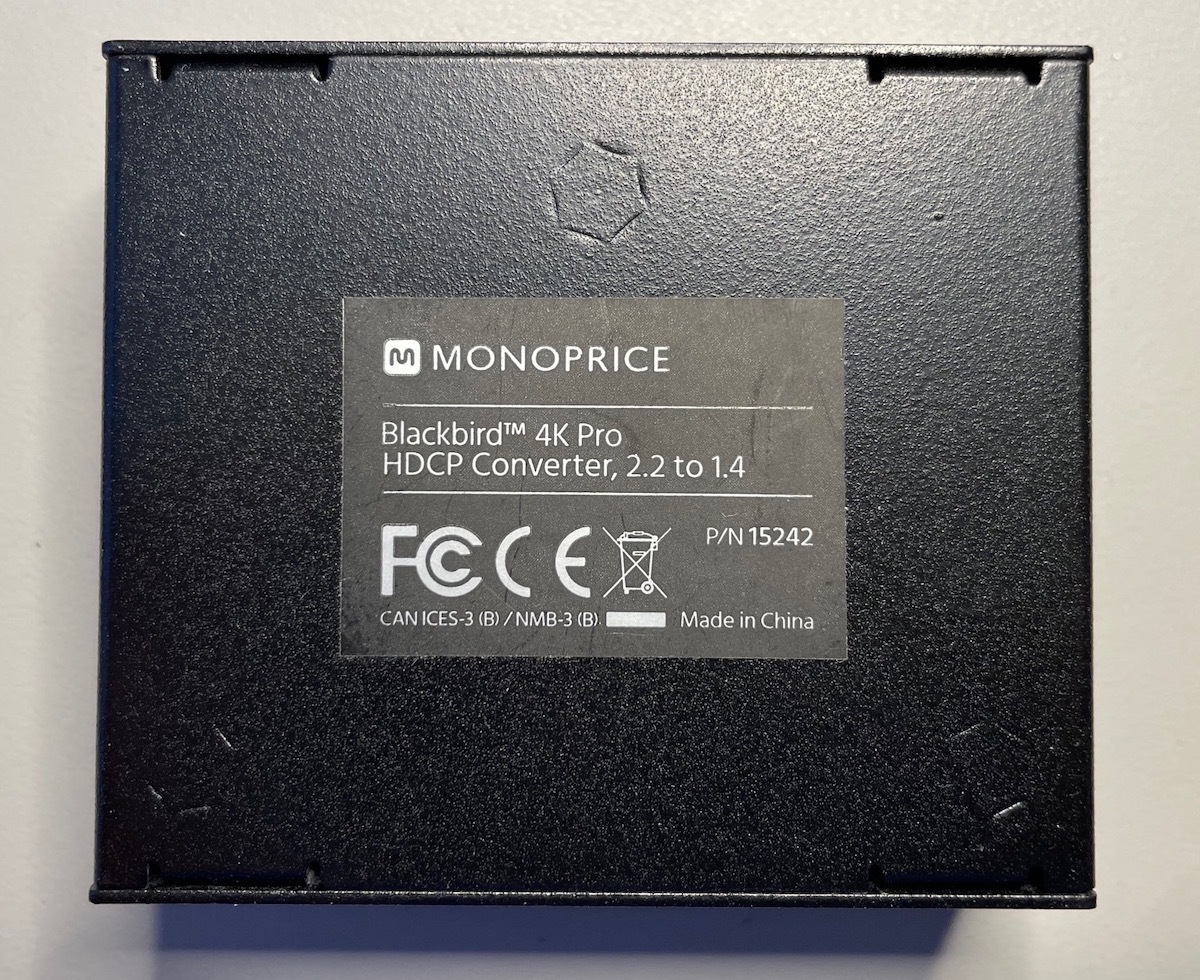
After removing the top cover, you’re greeted with the following:
The design is straightforward: a main conversion IC, an SPI flash memory, a microcontroller, and a bunch of jellybean components to create power rails.
Let’s look at the main actors:
-
Silicon Image Sil9679CNUC
Google has quite a bit of hits for this product, but they’re all articles from way back when HDCP 2.2 capable TV silicon was rare. This chip was the very first one that allowed televsion manufacturers to add support for HDCP 2.2 to their 4K TVs. It only supports the YUV 4:2:0 color format, but that’s sufficient for most TV content.
A few years ago, Silicon Image was acquired by Lattice Semiconductor, so the Sil9679 is now listed on the Lattice TV HDMI / MHL Receivers product page:
But there’s no datasheet to be found.
BTW, notice how the table above lists HDMI 2.0 support. Most people associate HDMI 2.0 with full quality 4K 60Hz support, which requires a cable bandwidth above the limit of HDMI 1.4. 4K 60Hz in YUV 4:2:0 mode, however, fits nicely within the capabilities of HDMI 1.4. It’s a mystery why the table claims HDMI 2.0 capabilities…2
A Google search for “Sil9679 datasheet” turns up a datasheet for the Sil9678 on LCSC. It’s a different product that does exactly the opposite: convert from HDCP 1.4 to HDCP 2.2, but it has the same packages and after close examination of the PCB, the pinout seems identical at well.
Chances are high that the Sil9678 and Sil9679 use the same silicon with different functions fused off…
-
STMicroelectronics STM8S005K6T6C Microcontroller
No secrets here: the datasheet is readily available.
This member of the STM8 series has an 8-bit CPU, 32KB of flash memory, 2KB of RAM, and the usual assortment of timers, UART, I2C, and SPI interfaces. It’s just what you need for some simple configuration and control of another chip.
-
Console Connector J1
You can visually trace the PCB traces from connector J1 to the STM8 controller: 2 pins are connected to its UART interface. We’ll soon have a closer look at that.
-
Debug Connector J2
The second pin of connector J2 is connected to the SWIM pin of the STM8. SWIM is short for Single Wire Interface Module. It’s a single-pin alternative of the more common JTAG interface and used to connect a debugger.
The Test
To test whether or not the HDCP converter works, I did a couple of experiments.
The equipment:
- an Amazon Fire TV Stick 4K
- a 15 year old Samsung TV, 1080p, no HDR, HDCP1 only
- a 5 year old Monoprice 4K 32” monitor, HDR support (terrible quality), HDCP1 only
- the Monoprice HDCP 2 to HDCP 1 converter
For content, I picked a random Amazon Prime show with UHD/4K and HDR10+ support: Z, the Beginning of Everything.
Samsung 1080p TV, Fire TV Stick, no converter
The first test counts as a base line. With the Fire TV plugged in straight into the old TV, I wanted to see whether or not there’d be a visual indication that the Fire TV was playing lower quality content.
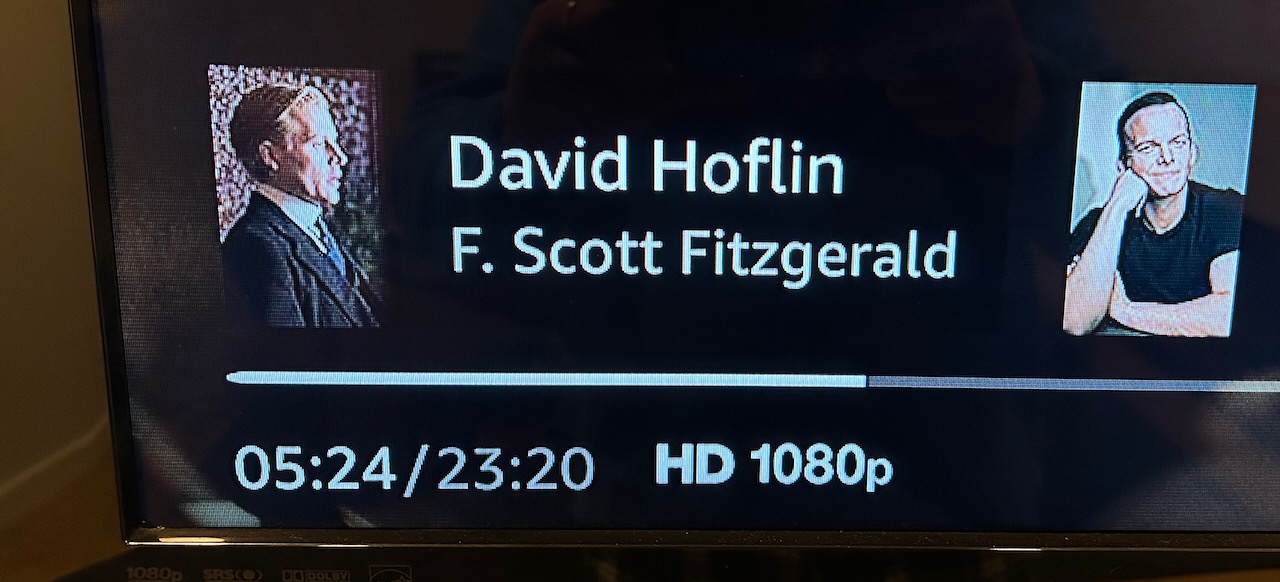
This was indeed the case. While the content browing screen indicated support for UHD and HDR10+, pressing pause during playing showed “HD 1080p”.
MonoPrice 4K monitor, Fire TV Stick, no converter
For the next step, I plugged the Fire TV directly into my 4K monitor. Since the monitor doesn’t support HDCP 2, I expected lower quality playback than 4K/HDR, and that’s what I got. This time, the player showed “HD 1080p HDR”.
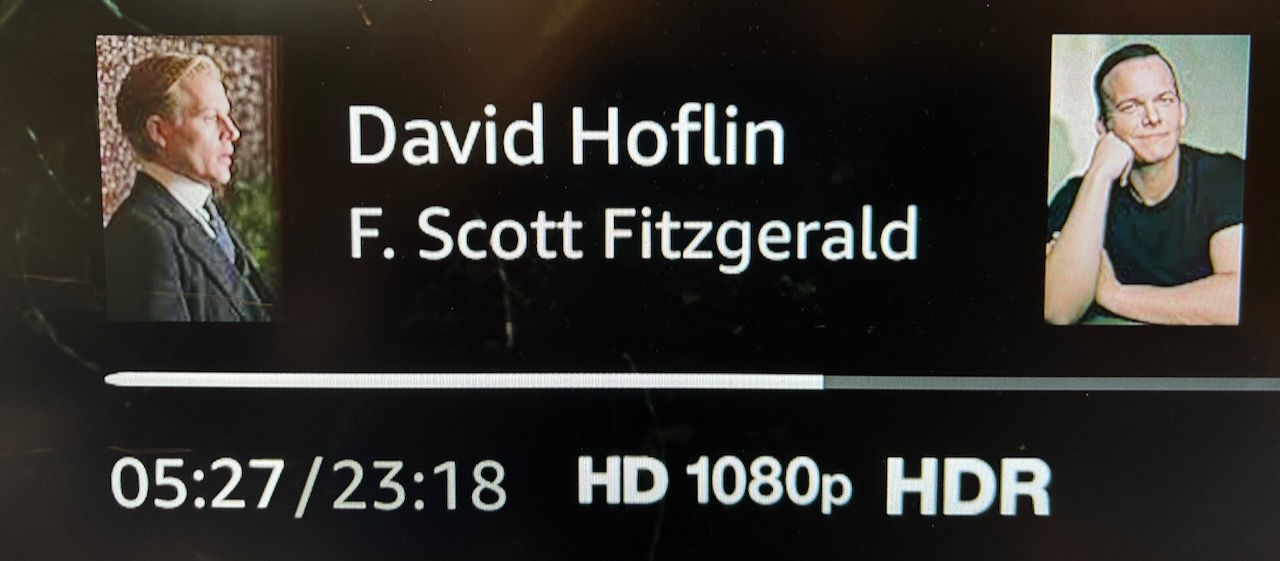
MonoPrice 4K monitor, Fire TV Stick, with HDCP converter
The final test puts the HDCP converter between the Fire TV and the monitor. If the converter does its job, I should be seeing 4K with HDR enabled.

And it does! The player now shows “Ultra HD HDR”.
As an intermediate conclusion, we can agree that the HDCP converter is definitely doing something that makes the Fire TV believe that it’s dealing with something better than an old HDCP1 enabled display.
But what is it doing exactly?
Digging Deeper: UART Transactions
Let’s dig deeper. The obvious next step is to wire up the UART pins of the microcontroller and see if there’s anything interesting to see there.
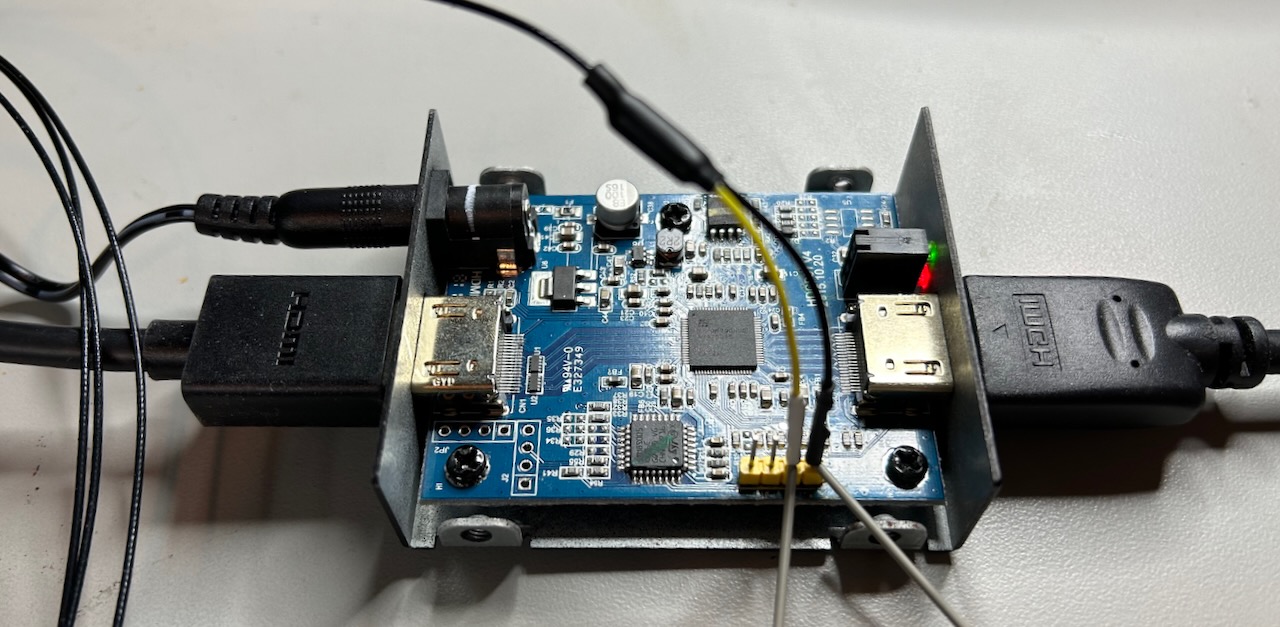
I used a USB to serial converter to capture UART traffic with a 115200 bit rate.
The TX port of the UART is chatty whenever there is some major event: booting up, plugging an HDMI cable in or out, or going to sleep. I typed a bunch of commands back to the device, but was not able to get an additional response of out it.
Booting Up
The message after plugging in the power cable:
Copyright Silicon Image Inc, 2013
Build Time: Aug 31 2015-14:50:30
Host Software Version: 01.02.02
Adapter Driver Version: 01.00.11
Require FW version: 02.02.xx
Waiting Boot Done ....
Booting is done successfully.
Chip ID: 0x9679
Firmware Version: 01.02.06
***Error: Chip FW Version not match.
Plugging in the sink
When I plug in the output HDMI cable to connect the monitor to the converter, it sends out this:
Downstream Connect Status Changed:
Link Type is: HDMI/DVI
Tx HDCP Version:
HDCP version is: 1.x
Tx HDCP Status Changed:
Tx HDCP Authentication Off.
Rx HDCP Version:
HDCP version not support
Rx HDCP Status Changed:
Rx HDCP Authentication Off.
Edid Status: Avaliable
Edid Block 0 Data:
00 ff ff ff ff ff ff 00 24 62 00 32 01 01 01 01
10 1c 01 03 80 47 28 78 3e 64 35 a5 54 4f 9e 27
12 50 54 bf ef 80 d1 c0 b3 00 a9 c0 95 00 90 40
81 80 81 40 81 c0 40 d0 00 a0 f0 70 3e 80 30 20
35 00 54 4f 21 00 00 1a b4 66 00 a0 f0 70 1f 80
30 20 35 00 80 88 42 00 00 1a 00 00 00 fc 00 48
44 4d 49 32 0a 20 20 20 20 20 20 20 00 00 00 fd
00 18 90 0f de 3c 00 0a 20 20 20 20 20 20 01 30
Edid Block 1 Data:
02 03 4f f2 5e 04 05 10 13 14 1f 20 21 22 27 48
49 4a 4b 4c 5d 5e 5f 60 61 62 63 64 65 66 67 68
69 6a 6b e2 00 c0 e3 05 c0 00 23 09 7f 07 83 01
00 00 e5 0f 00 00 0c 00 67 03 0c 00 10 00 38 78
67 d8 5d c4 01 78 88 01 e6 06 05 01 69 69 4f 02
3a 80 18 71 38 2d 40 58 2c 25 00 55 50 21 00 00
1e 69 5e 00 a0 a0 a0 29 50 30 20 35 00 00 b0 31
00 00 1e 00 00 00 00 00 00 00 00 00 00 00 00 df
We can see how it doesn’t go through HDCP authentication yet, but it waits for the source on the input HDMI port.
The EDID data contains all the information about the connected monitor: supported resolutions and refresh rates, colometry information, audio modes and so forth. After removing the “Edid Block 1 Data”, you can paste these hex values straight into an online EDID parser to convert the binary EDID information into a readable format.
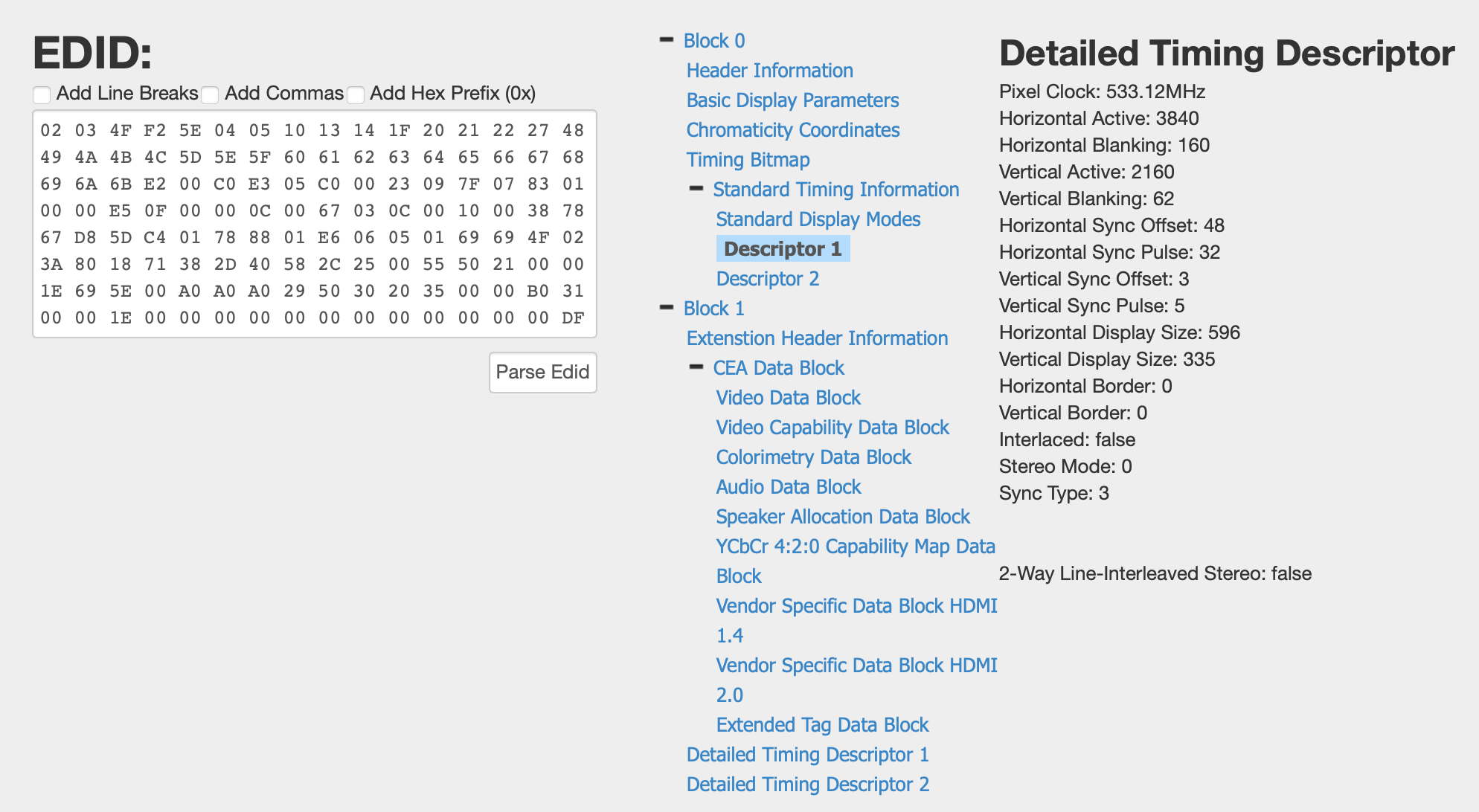
The converter needs this EDID data so that it can pass it on to the upstream source device on its input port.
Plugging in the source
Most important is what happens when plugging in the source:
Upstream Connect Status Changed:
Link Type is: HDMI/DVI
Sync Detect: ON
Clock Detect: ON
Rx HDCP Version:
HDCP version is: 2.2
Rx HDCP Status Changed:
Rx HDCP Authenticating...
AV Mute Status Changed:
AV Mute ON
Tx HDCP Version:
HDCP version is: 1.x
Tx HDCP Status Changed:
Tx HDCP Authenticating...
Rx HDCP Version:
HDCP version is: 2.2
Rx HDCP Status Changed:
Rx HDCP Authenticating...
AV Mute Status Changed:
AV Mute OFF
Tx HDCP Version:
HDCP version is: 1.x
Tx HDCP Status Changed:
Tx HDCP Authentication Done.
Rx HDCP Version:
HDCP version is: 2.2
Rx HDCP Status Changed:
Rx HDCP Authenticating...
Rx HDCP Version:
HDCP version is: 2.2
Rx HDCP Status Changed:
Rx HDCP Authentication Done.
We can see how the input/RX and the output/TX port go through an HDCP2 and HDCP1 authentication respectively.
Unfortunately, the console log still doesn’t tell us whether or not the HDCP2 authentcation is for type 0 or type 1 content.
Decoding HDCP I2C Transactions
To really know what’s going on, we need to observe the control traffic that runs over the Display Data Channel (DDC) of the HDMI cable. DDC uses the standard I2C protocol that can be decoded by any self-respecting logic analyzer or oscilloscope.
The SCL and SDA signals of the DDC channel are present on pins 15 and 16 of the HDMI connector.
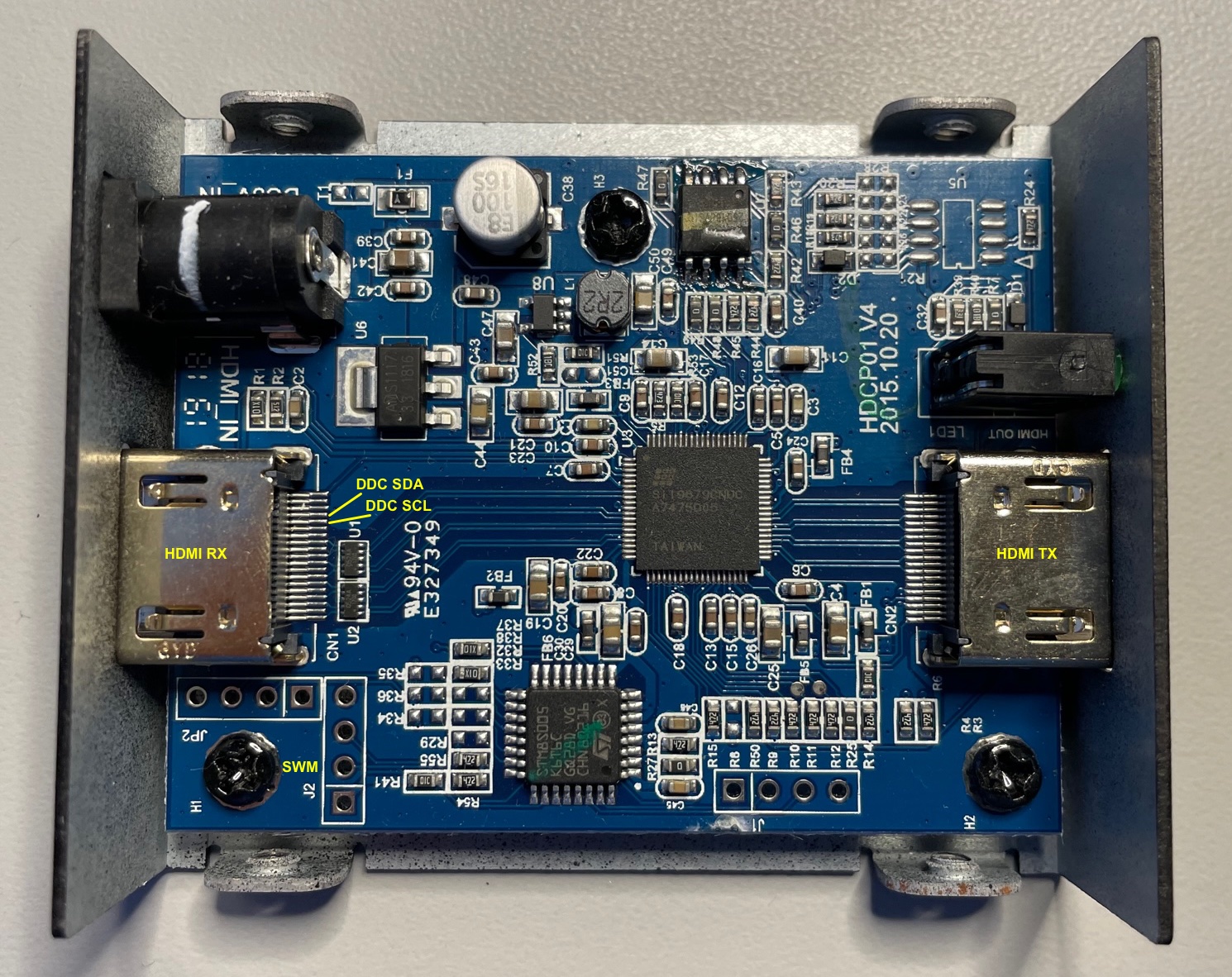
It takes a bit of patience, a steady hand, and, in my case, a microscope to solder two tiny wires to those pins, but it’s totally doable with a fine tipped soldering iron. Once in place, you can capture the I2C transactions with a logic analyzer such as a Saleae or DSLogic for further analysis:
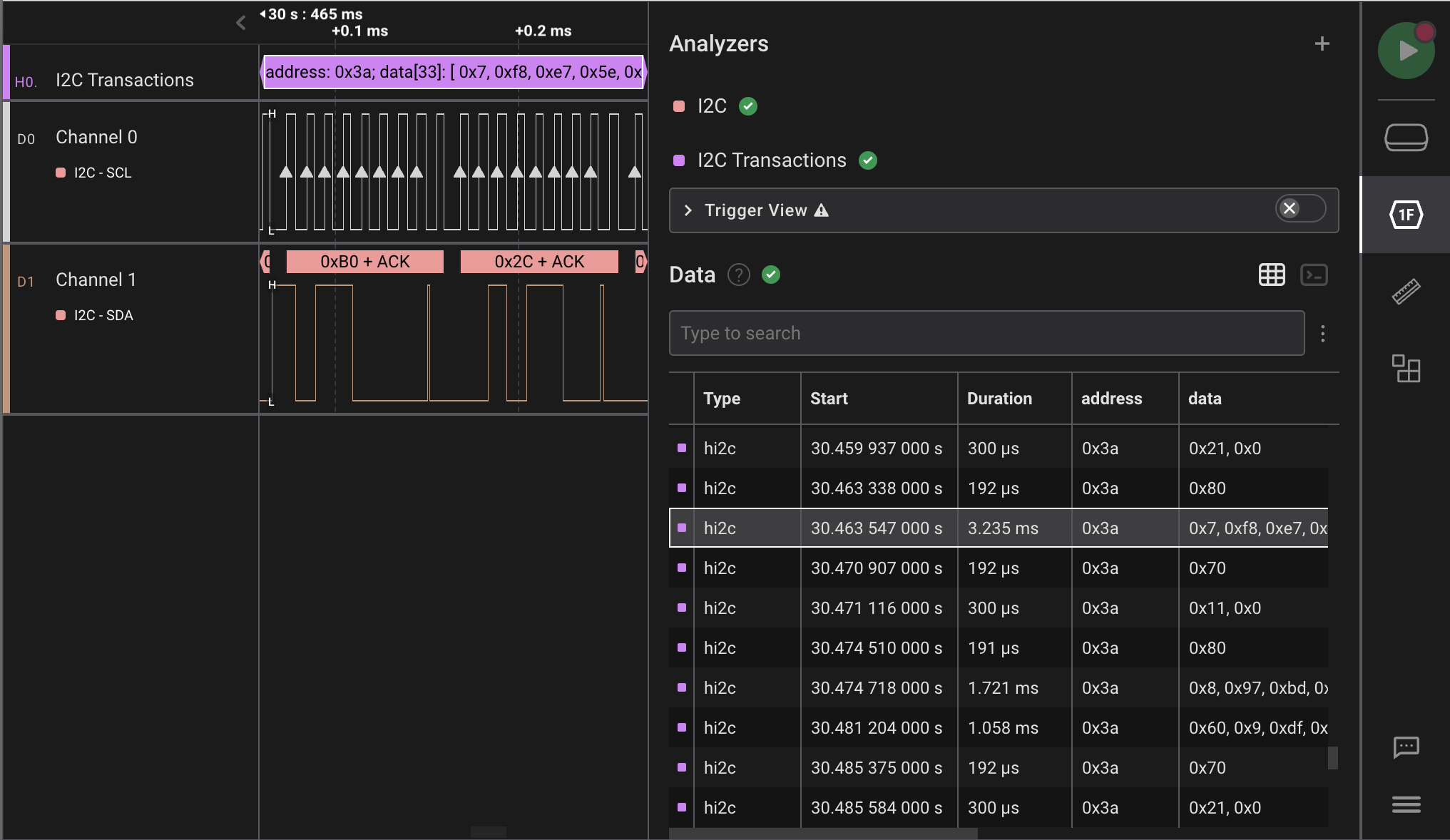
There are multiple I2C devices on the DDC bus:
-
EDID: address 0x50
This contains the EDID information that we saw earlier on the console log. On many older monitors there’s literally an I2C PROM soldered onto the wire. Newer monitors handle EDID I2C requests with an I2C device controller in the scaler chip.
-
SCDC: address 0x54
The Status and Control Data Channel was introduced for HDMI 2.0. For earlier versions, data transmission over the high-speed HDMI links was a pure one-way fire-and-forget affair. HDMI 2.0 added status registers to observe link quality and control registers to set the clock to data ratio, enable or disable scrambling operation and more.
The HDMI converter only supports HDMI 1.4, so you can expect source requests to address 0x54 to result in an I2C NAK (not-acknowledged) response.
-
HDCP: 0x3A
This address is used for read and write access to various HDCP registers that are used to exchange authentication and status information.
I2C Transactions
Let’s walk through the key I2C transactions of the recorded trace.
Initially, nothing is connected, and the sink, the RX port of the HDCP converter in this case, doesn’t respond:
// HDCP... Nothing connected
write to 0x3A nak
...
write to 0x3A nak
Next, the source reads the EDID information:
// Read EDID Page 0
write to 0x50 ack data: 0x00
read to 0x50 ack data: 0x00 0xFF 0xFF 0xFF 0xFF 0xFF 0xFF 0x00 ...
// Read EDID Page 1
write to 0x50 ack data: 0x80
read to 0x50 ack data: 0x02 0x03 0x4F 0xF2 0x5E 0x04 0x05 0x10 ...
The source then checks if it’s dealing with an HDMI 2.0 sink. It is not, so the access results in a NAK:
// SCDC
write to 0x54 nak
The source is now ready to enable HDCP protection. HDCP documents can be found on the HDCP Specifications page of the Digital Content Protection consortium.
There are specifications that describe the general principles, such as the HDCP Specification Rev. 2.2 Interface Independent Adaptation document, as well as specifications with interface specific implementation details, such as the HDCP 2.3 on HDMI Specification. We can use the latter to decode the meaning of the I2C transactions. Section 2.14 HDCP Port shows all the supported I2C registers.
First, the source checks the HDCP2Version register. Bit 2 of register 0x50 indicates that HDCP2 is supported.
// HDCP HDCP2Version
write to 0x3A ack data: 0x50
// Supports HDCP2.2 or higher
read to 0x3A ack data: 0x04
This is then followed by the actual cryptographic exchange sequence.
The source indicates that it wants an HDCP2 authentication:
// HDCP Write_Message: msg_id=0x02 AKE_Init, Data len=11
// Last 3 bytes: 0x02 0x00 0x00 -> HDCP transmitter version = 0x02
write to 0x3A ack data: 0x60 0x02 0xBB 0xDA 0x14 0x6B 0x44 0xFB 0x1A 0x0C 0x02 0x00 0x00
This results in the sink returning a message that is 534 bytes long. It contains the monitor’s authentication certificate, a public key, but also whether or not the sink is a final terminal or a repeater:
// HDCP RxStatus
write to 0x3A ack data: 0x70
// Message length 0x216/534
read to 0x3A ack data: 0x16 0x02
// HDCP Read_Message
write to 0x3A ack data: 0x80
// Read 534 bytes: msg_id=0x03 AKE_Send_Cert
// Last 3 bytes: 0x02 0x00 0x00 -> RxCaps: receiver version 0x02, REPEATER=0 (!)
read to 0x3A ack data: 0x03 0xF1 0x60 0xD1 0x6B ... 0x02 0x00 0x00
The sink indicates that it is NOT a repeater. This is the information I was looking for: repeaters have strict rules about how to deal different types of content and are NOT allowed to forward type 1 content.
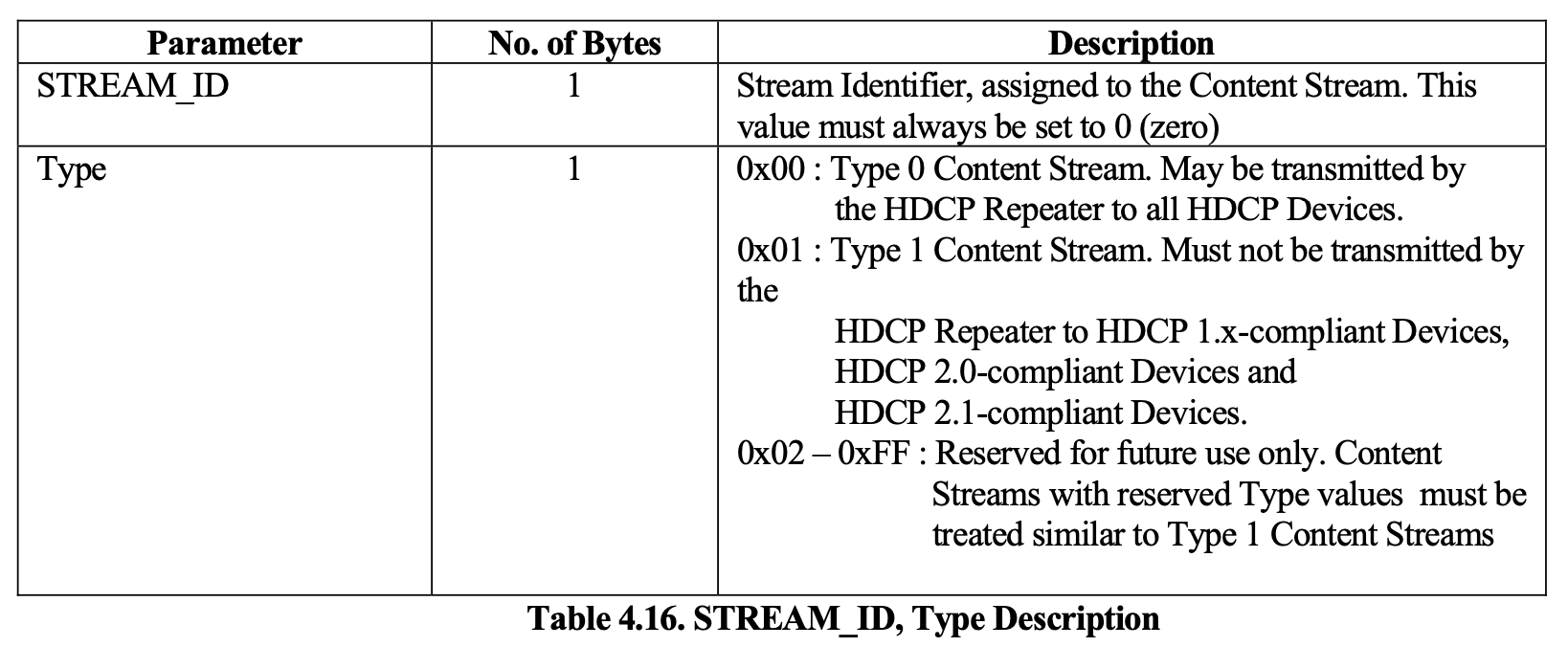
The HDCP converter simply announces itself as a final video endpoint… yet still repeats the content to its output port. Without a very expensive HDMI protocol analyzer, we can’t check if the source is tagging the content as type 0 or type 1, but there is no reason now to think that it’s not type 1.
The rest of the I2C trace follows the HDCP specification authentication playbook, but doesn’t provide any more clues about the content type.
The trace ends with the source polling the sink at regular interval to make sure the HDCP link is still active:
// HDCP RxStatus
write to 0x3A ack data: 0x70
read to 0x3A ack data: 0x00 0x00
write to 0x3A ack data: 0x70
read to 0x3A ack data: 0x00 0x00
...
The Legality of It All
All of this made me question the legality of all this. Monoprice sells cheap products, but it’s not a shady bottom feeder. After a bit of Googling around, I found the following article.
There has been a lawsuit about this kind of down-converter, but the case was settled. Here’s the money quote:
In its reply, LegendSky explained that their devices do not “strip” any HDCP copy protection. Instead, the contested HDFury device merely downgrades the higher HDCP protection to a lower version, which is permitted as an exception under the DMCA.
And that’s the end of the story: the converters work, they’re passing through type 1 contents, and there’s nothing the movie studios can do about it. It’s all good.
References
- HDCP Specifications
- A Cryptanalysis of the High-bandwidth Digital Content Protection System
- A cryptanalysis of HDCP v2.1
- hdcp-genkey
Footnotes
-
It wasn’t necessary for someone in-the-know to leak the master key: the protocol was so flawed that the master key can be derived using the technique described in “A Cryptanalysis of the High-bandwidth Digital Content Protection System” by Crosby, et al. ↩
-
You can the bandwidth requirements with my video timings calculator. Just chose 4K/60 in the predefined mode selection box, and toggle between the RGB 4:4:4 or YUV 4:2:0 color formats. You’ll see how RGB 4:4:4 requires HDMI 2.0 while YUV 4:2:0 works with HDMI 1.4.
